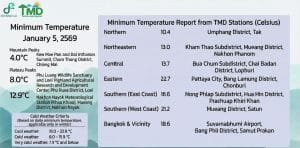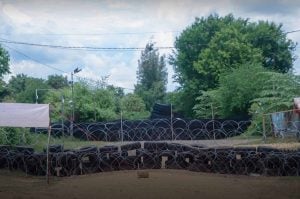Caterpillars chomp through 150-rai lotus pond in record time

Millions of caterpillars devoured a 150-rai (approximately 60 hectares) lotus pond at Bueng Phra in Chokchai District, Nakhon Ratchasima, within two weeks. Experts identified the culprit as the Nhon Bung caterpillar, a type of moth larvae that prey on lotus plants.
What was once a picturesque lotus pond, brimming with vibrant pink blossoms just two months ago, has now turned into a brown, withered expanse. The transformation has shocked locals and visitors alike.
Residents report that these caterpillars have ravaged the lotus leaves and flowers in less than two weeks. Thawatchai Kanpimai, a local fisherman, described the scene.
“The lotuses that you see drying up across the pond are the work of a small caterpillar, about the size of a matchstick, with bristles all over its body.”
Thawatchai mentioned that he frequently encounters these caterpillars while checking his fish traps in the pond, but they do not cause him any irritation. He noted that the caterpillars primarily target lotus and cattail plants around the pond and do not seem to affect other vegetation.
This phenomenon is not entirely new to the area. According to locals, such outbreaks occur almost every year around this time. The caterpillars feed on the lotuses until they wither and turn brown. However, once the caterpillars have finished their cycle, new lotus leaves eventually grow back, restoring the pond to its former beauty.
Caterpillar carnage
Associate Professor Dr Jariya Roddee from the Department of Plant Production Technology at Suranaree University of Technology confirmed the identity of the caterpillars after examining images sent by reporters.
“These are Nhon Bung caterpillars, also known in some regions as Bai Bua caterpillars. They are the larvae of nocturnal moths.”
The adult moths lay their eggs on the lotus leaves, and once hatched, the larvae consume the leaves and flowers, leaving only the central veins intact.
Dr Jariya outlined the lifecycle of these pests. After feeding, the caterpillars pupate and eventually emerge as adult moths, which then mate and lay eggs, continuing the cycle. She emphasised that the abundance of food sources accelerates the spread and damage caused by these caterpillars, making them difficult to control.
Despite the extensive damage, Dr Jariya noted that the affected lotuses are capable of regenerating. In cultivated lotus fields, farmers often use chemical treatments to manage these pests. However, in public and natural water bodies like Bueng Phra, letting the natural cycle run its course might be the only option, reported KhaoSod.
Environmental factors such as weather, humidity, and sustained high temperatures contribute to the rapid and extensive damage. The abundance of food sources also plays a crucial role in the caterpillars’ proliferation.
Latest Thailand News
Follow The Thaiger on Google News:


























